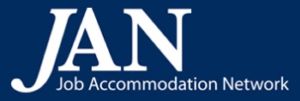
College graduation always feels like it sneaks up faster than we all expect, and for many colleges and universities throughout the U.S., it’s just a few months away! Graduating and transitioning from school to the workplace can be an intimidating experience for students with disabilities, and the first step in that transition – job-seeking – can feel especially daunting. Here, we’ll review some of the job-seeking resources available through the Job Accommodation Network (JAN), which you can share with your graduating student(s) with disabilities if they feel like they may need some additional help in kicking off the process of starting their careers.
Beginning to look for a job can get overwhelming – there are so many different companies, job listings, locations, and minute details to sort through. To ease some of this stress, JAN suggests starting with their simple list of Do’s and Don’ts of Looking for a Job. Some of the items in the list may seem obvious when you look at them, but they’re the sorts of tips that can get lost under the mountain of listings and applications we often find ourselves sorting through while job-hunting. JAN also has much more detailed guidance in the form of their Employment Guide, which dives deep on individual questions, options, and information that may come up during the job-hunting, application, interview, and offer stages of employment. The webpage provides brief section descriptions of the guide’s content, while the guide itself is available to download as a PDF or Word document.
Once a student with disabilities has an idea of the sort of job they may want to apply for, it’s time to begin seeking out those specific jobs and sending in applications. JAN has a number of suggestions for websites to help job-seekers find and apply to various positions, including HireDS, Recruit Disability, Talent Acquisition Portal, and Chronically Capable. In addition to aiding the seeking and application processes, many of these sites have additional resources and tips of their own, similar to those provided by JAN. Job-seekers with disabilities may have some concerns about disclosing their disability to potential employers during this application process, but by and large, employers can’t require an applicant to disclose information about their disability before they’ve made an offer of employment – you can find more detail about this through JAN and the U.S. Equal Employment Opportunity Commission (EEOC).
The next step, of course, is interviewing, which can also feel like an intimidating or tricky stage to navigate for a person with disabilities. Interviews vary widely from company to company, so it can be hard to go in feeling 100% confident. JAN’s Employment Guide, mentioned above, has a section specifically about interviews with a great deal of detail on how to prepare and what to expect. Additionally, Ticket to Work’s article on navigating a job interview answers five key questions that applicant with disabilities often have. When your student with disabilities gets their job offer(s), it’s time to start planning for the potential need for disclosing their disability and requesting an accommodation. JAN has a detailed guide on requesting accommodations, plus a page, a training module, and videos on disclosure.
Beyond those listed above, JAN has many more resources to choose from. These include more resources for job-seekers, resources for people with disabilities who are already employed, and even for those seeking entrepreneurship. There are also resources for employers and other professionals who seek to support their employees and colleagues with disabilities.
Resources
Job Accommodation Network (JAN)
JAN: Do’s and Don’ts of Looking for a Job
JAN: Employment Guide
JAN: Disability Disclosure
JAN: Disability Disclosure Training Module and Videos
JAN: Guide to Requesting Accommodations
JAN: Additional Resources
HireDS
Recruit Disability
Talent Acquisition Portal
Chronically Capable
EEOC: Job Applicants and the ADA
Ticket to Work: Pre-Employment and the ADA: 5 Tips for Navigating a Job Interview




 See More Feature Articles
See More Feature Articles